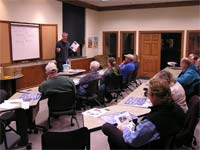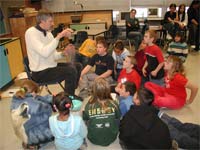|
  
4-H Lesson Plans:
The lesson plans and activities below were developed for the 4-H Program. They have been aligned with National Science Education Standards (NSES) for grades K-4, 5-8 and 9-12.
Through a hands-on experiment, the participants will examine a rain gauge, understand the measurements on a rain gauge and practice reading measurements of water using a rain gauge.
Through a hands-on experiment, the participants will see and discuss water vapor and the formation of a cloud.
An ongoing project where participants photograph, observe and identify clouds compiling a scrapbook. Upon completion of this project/activity, participants will have a better understanding of cloud types and the weather associated with them and the use of technology to record clouds.
Suspending a ping pong ball in the stream of air supplied by a hair dryer will demonstrate how rain and hail are supported in storms.
Through an experiment with hot and cold water, participants will see warm water rising due to thermal buoyancy or the same principal behind hot air balloons.
Participants will discover that as substances heat up, their molecules speed up and spread apart, causing the substance to expand. Recommended for grades K-4.
Participants will make a mini-tornado using water in a jar and will see a that a tornado is a vortex; a spiral motion of fluid (of air) that sucks everything near it toward its center.
Students will understand that static electricity is the cause of lightning and that lightning forms because of an accumulation of electrical charges inside a cloud due to friction from dust, ice, and water droplets. Lightning safety is also discussed.
Through a hands-on demonstration, participants will see sparks of electricity and make a comparison to lightning.
|